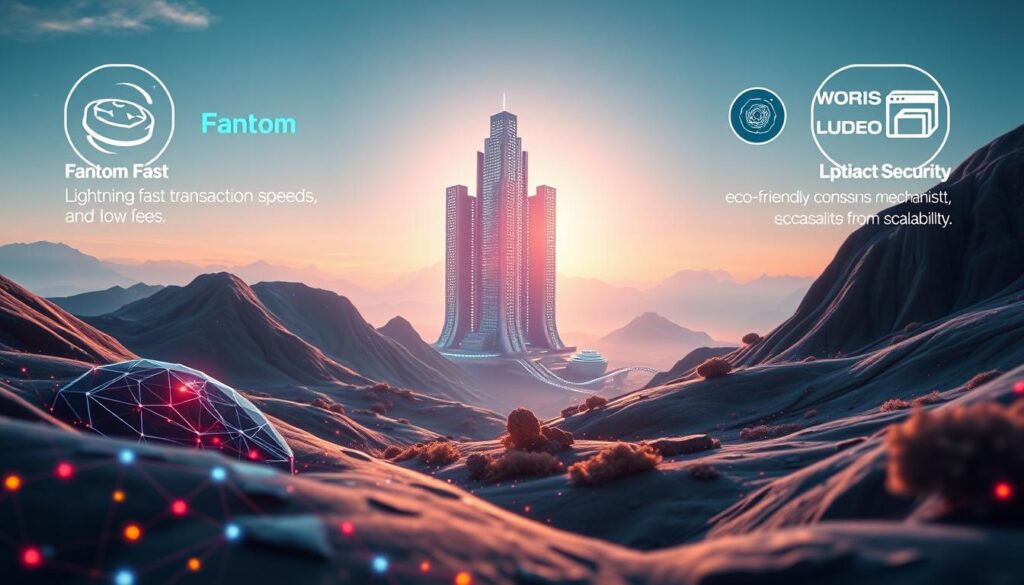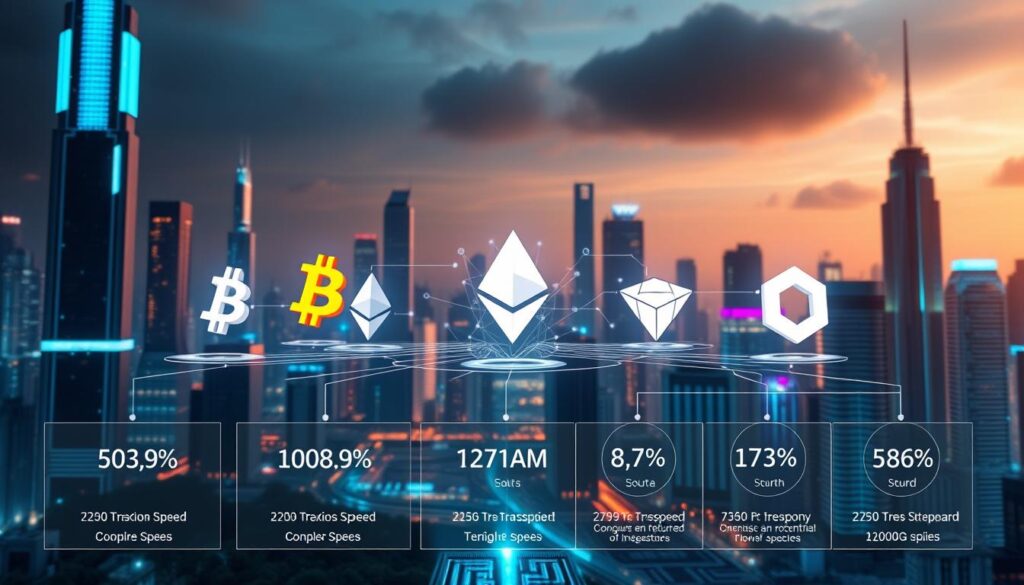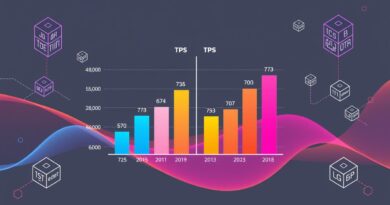Fantom (FTM) Crypto: Understanding the Benefits and Risks
Fantom transactions are super fast, taking just 1–2 seconds. This is much quicker than Bitcoin’s 10- to 15-minute wait. The cost of each transaction is just $0.0000001, which is much lower than Ethereum’s high fees.
FTM’s price has seen a huge jump of 19,500% from its launch in 2019. It reached $3.41 in 2022 but then dropped by 90% by the end of the year. Fantom’s Lachesis consensus and EVM compatibility make it powerful. But, its price swings show the risks of holding FTM.
Fantom’s FTM token is the 43rd-largest cryptocurrency. Its architecture supports infinite decentralized systems and is scalable. Now, over 26.6 million unique addresses use its network, up from 5,000 in 2021.
This guide will look at Fantom’s technical innovations, DeFi applications, and the balance between its speed and market volatility.
Key Takeaways
- Fantom’s 1–2 second transaction speed outperforms Bitcoin’s 60-minute finality and Ethereum’s 6-minute delays.
- FTM’s fees average $0.0000001, making it 300,000x cheaper than Ethereum’s $0.30 average.
- FTM’s price surged 19,500% from 2019 but lost 90% of its value in 2022, showing extreme volatility.
- Its Lachesis consensus mechanism ensures fast finality without sacrificing security or centralization.
- Fantom’s EVM compatibility attracts developers, powering DeFi apps like SpookySwap and Multichain with over 26.6 million users.
Introduction to Fantom (FTM)
Fantom is a decentralized blockchain platform. It aims to solve the scalability issues of older networks like Bitcoin and Ethereum. It uses a Directed Acyclic Graph (DAG) architecture and the Lachesis consensus protocol.
This crypto technology makes transactions settle in 1–2 seconds. This is much faster than traditional systems.
- Handles over 2,000 transactions per second (TPS) with Sonic upgrades
- Reduces node storage needs by 90% via the Carmen database
- Supports smart contracts compatible with Ethereum Virtual Machine (EVM) apps
The FTM token is used for staking and governance. Users need to stake 1 FTM to participate. Validator nodes require 3,125,000 FTM.
Fantom has a total supply of 3.175 billion tokens. Its ecosystem includes over 150 independent blockchains as of 2022. Its consensus mechanism ensures security even if a third of nodes act maliciously.
Launched in 2018, Fantom’s mainnet debuted in 2019. The Fantom Foundation manages development, backed by a team of 12 core developers. Early investors in its $39.6 million ICO saw price swings.
But the platform’s DeFi tools now support over $10 billion in locked assets. This blockchain combines speed, low fees, and interoperability. It positions itself as a leader in next-gen crypto technology.
The History and Development of Fantom
Fantom launched in 2018 with a goal to improve crypto technology. It aimed to solve speed and scalability issues. Today, it has a $689 million market cap, showing its success in decentralized networks.
Origins and Vision of Fantom
Dr. Ahn Byung Ik, a computer scientist, started Fantom. He wanted to fix blockchain’s problems. Fantom uses a DAG-based architecture for fast transactions.
The Lachesis consensus mechanism was introduced in 2018. It focuses on speed without losing security.
Major Development Milestones
- 2018: Fantom’s ICO raised $369 million, securing 40% of FTM tokens.
- 2019: Opera mainnet launched, supporting Ethereum-compatible smart contracts.
- 2020: Partnership with Binance Chain expanded cross-chain interoperability.
- 2022: Sonic upgrade reduced fees by 99%, boosting daily transactions to 1 million+.
By 2022, Fantom’s TVL hit $12.2 billion, beating Binance Smart Chain. Top DApps like SpookySwap and Geist Finance now hold over $100 million in TVL.
The Team Behind Fantom
CEO Michael Kong leads Fantom’s technical strategy. He has experience in blockchain incubation. CTO Quan Nguyen oversees the Lachesis consensus protocol.
DeFi architect Andre Cronje created key tools like fUSD and fSwap.
“Fantom’s modular design adapts to evolving crypto markets,” explains developers.
Today, Fantom’s 12-member core team and 30+ contributors work on expanding FTM’s ecosystem. They aim to lead in low-cost blockchain solutions.
How Fantom’s Consensus Mechanism Works
Fantom’s blockchain uses a special smart contracts-based Lachesis consensus mechanism. It’s different from other crypto technology systems. Lachesis runs on an asynchronous Byzantine Fault Tolerant (aBFT) protocol.
This protocol lets nodes check transactions on their own. They don’t have to wait for everyone to agree. This makes transactions faster.
Lachesis is built on a Directed Acyclic Graph (DAG) structure. This setup lets validators work on transactions at the same time. It can handle over 2,000 transactions per second.
Each validator has its own DAG. They agree on event blocks when 67% of them confirm. This keeps the network safe, even if some nodes act badly.
- Transactions finalize in 1–2 seconds, versus Ethereum’s 12–14-second block time.
- No energy-intensive proof-of-work; validators stake FTM tokens to secure the network.
- Scalability without sacrificing security through aBFT’s fault tolerance.
Ethereum’s proof-of-stake takes longer because it confirms blocks one after another. Fantom’s DAG avoids this delay. It makes transactions almost instant.
This fast process works well with Fantom’s smart contracts. It powers apps like SpookySwap and Geist. This makes Fantom a leading blockchain for big applications.
Key Features of the Fantom Blockchain

Fantom’s blockchain is a game-changer in crypto tech. It offers speed and low costs that set it apart. The Opera mainnet supports EVM compatibility, making it easy for developers to create smart contracts.
The network’s design prevents congestion. It supports independent blockchains for each project. Plus, it has cross-chain bridges to networks like Binance Chain.
| Feature | Fantom | Ethereum | Solana |
|---|---|---|---|
| Transaction Speed | 1-2 seconds | 12-15 seconds | 0.4 seconds |
| TPS | 2,000+ | 15-30 | 50-65 |
| Transaction Fees | $0.0000001 | $20–$200 | $0.0001–$0.01 |
Speed and Scalability
Fantom’s Lachesis protocol offers instant finality in 1–2 seconds. This is much faster than Ethereum’s 12-second wait. It can handle 2,000+ transactions per second, making it 100x faster than Ethereum.
This speed is great for apps that need to handle a lot of traffic without slowing down.
Low Transaction Costs
Fantom’s fees start at just $0.0000001. This is much lower than Ethereum’s fees. The network burns 30% of fees to reduce inflation and reward validators with FTM.
This approach keeps costs stable, even when the network is busy.
Cross-Chain Interoperability
Fantom connects to Ethereum, Binance Chain, and Solana through cross-chain bridges. Its ERC-20 compatibility makes it easy to transfer assets between networks. The partnership with Binance has expanded Fantom’s ecosystem, making it easier to transfer crypto across platforms.
Smart Contract Capabilities
Developers can use the Fantom Virtual Machine (FVM) to run Ethereum-based smart contracts without changes. Over 23 DeFi dApps, like SpookySwap, use Fantom’s smart contract features. The FTM token is used for fees, staking, and governance.
Fantom’s Role in Decentralized Finance (DeFi)
Fantom is a top player in decentralized finance. It makes it easy for users to work with digital assets. Its blockchain is compatible with EVM, making it simple for developers to create DeFi apps.
Today, Fantom has over 23 DeFi apps. These apps let users create, trade, and borrow assets quickly and affordably.
The FTM token is key for governance and staking. It rewards users for helping keep the network safe. Projects like SushiSwap and C.R.E.A.M. Finance use Fantom for yield farming and more.
Transaction fees on Fantom are often under $0.01. This is much cheaper than Ethereum. Plus, transactions are confirmed almost instantly.
- fMint: Creates synthetic assets tied to real-world markets
- fLend: Facilitates lending and borrowing with minimal slippage
- fTrade: Decentralized exchanges with low-fee trading
Fantom’s decentralized finance ecosystem is growing fast. Its TVL is higher than Solana’s. It works well with Ethereum, attracting many developers.
Staking FTM can earn users up to 6% annually. Validators need at least 50,000 FTM to secure the network.
Fantom is a leader in DeFi because of its speed, low costs, and tools for developers. It makes it easier for people to trade, stake, or build with digital assets.
Investment Benefits of Fantom (FTM)

Fantom’s FTM token offers unique chances for investors in the crypto world. It combines yield-generating features with blockchain innovation. This mix promises growth for investors.
Staking and Yield Opportunities
FTM holders can earn returns from 1.97% to 6.04% by staking. You can lock FTM for 14 days to 365 days for rewards. Liquid staking lets users mint sFTM tokens, keeping liquidity while earning.
For example, locking FTM for a year can yield 6.04% APY. This combines passive income with the flexibility to use your capital.
“Fantom’s Lachesis aBFT consensus enables transaction finality in 1-2 seconds, boosting its appeal for decentralized finance applications.”
Growth Potentials as a Layer-1 Solution
Fantom’s blockchain design is faster and cheaper than others. In 2021, its TVL jumped from $300M to $8.1B during the DeFi boom. Though TVL fell to $496M, its 2024 price recovery shows it’s resilient.
Analysts predict FTM could hit $1.81 by late 2024, a 174% rise from now.
- 2024: Experts project FTM could reach up to $1.81, per Telegaon.
- 2025: DigitalCoinPrice expects a high of $1.68, highlighting layer-1 scalability.
Ecosystem Expansion and Token Value
Fantom’s ecosystem growth boosts token utility. Partnerships with companies and DeFi platforms increase adoption. The token’s dual role in paying fees and securing the network creates demand.
Historical data shows FTM’s 2021 peak at $3.46, showing its volatility but also its growth. Current TVL trends and cross-chain interoperability reinforce its value in crypto technology.
As Fantom enters gaming, payments, and enterprise solutions, FTM’s role in decentralized finance grows. Investors look for milestones like the Sonic upgrade to unlock scalability and adoption, further increasing token value.
Risks and Challenges in the Fantom Ecosystem
Fantom faces tough competition in the crypto world. Big names like Ethereum lead in DeFi, with over $30 billion in TVL. Fantom has $496 million, ranking 10th, behind Avalanche and Solana.
Technical issues are a big worry. Fantom’s Lachesis consensus is fast but had a $126 million hack in 2023. It can handle up to one-third faulty nodes, which is risky. Validators need 500,000 FTM to join, which might limit decentralized control.
Market ups and downs also pose risks. Fantom’s TVL dropped 83% in a year, showing crypto’s volatility. Global rules on blockchain could slow adoption. Fantom’s inflation rate is 2%, but it’s going down, which is good for the long run.
- Competitive pressure from Ethereum and Solana’s scalability efforts
- Risk of smart contract exploits despite rapid transaction speeds (30 TPS)
- Dependence on high TVL growth to sustain ecosystem value
Investors need to think carefully about Fantom’s future. Fantom plans to improve with Sonic network scaling to 2,000 TPS. But, beating big competitors and security issues will show if it’s a top blockchain.
Fantom vs. Competing Blockchain Networks

Fantom faces tough competition from Ethereum, Solana, and Avalanche in the crypto world. It offers fast smart contracts and low fees. Yet, its ecosystem is smaller than Ethereum’s.
This section will compare Fantom’s blockchain features with its rivals. We’ll look at performance, costs, and ecosystem size to see how it stacks up.
“The question is, what is the point of using Fantom once Ethereum establishes scalability?”
Fantom vs. Ethereum
Ethereum is working on a Proof of Stake upgrade to match Fantom’s speed. But Fantom’s Lachesis consensus already handles 10,000 TPS, while Ethereum does 20 TPS. Fantom’s EVM compatibility makes it easier to deploy smart contracts, but Ethereum’s huge developer community is a big plus.
Ethereum’s sharding upgrade could challenge Fantom’s speed advantage. This might shake Fantom’s position in DeFi.
Fantom vs. Solana
Solana can process 60,000 TPS but often has outages. Fantom, on the other hand, handles 10,000 TPS without any downtime. Fantom’s FTM token offers staking APYs up to 13% for a year, beating Solana’s 5%.
Both networks have low fees, but Fantom’s reliability and EVM support attract more developers. They prefer stability over high speeds.
Fantom vs. Avalanche
Avalanche can handle 6,500 TPS and has a subnet approach. Fantom’s EVM compatibility makes it easier for Ethereum developers to join. But Avalanche’s $0.12 transaction fees are higher than Fantom’s sub-$0.01 fees.
Fantom has 65 nodes for fast validation, but Avalanche’s 1,000+ nodes improve decentralization. Avalanche’s subnet approach offers flexibility, but Fantom’s design is more straightforward.
Competitive Advantages and Disadvantages
Fantom’s strengths include:
- 10,000 TPS and $0.01 fees for crypto transactions
- EVM compatibility easing smart contract migration
But Fantom also has weaknesses:
- Only $485M TVL versus Ethereum’s $30B dominance
- Limited unique use cases beyond DeFi
Fantom’s FTM token offers yield opportunities, but its ecosystem lacks diversity. To succeed, Fantom needs to innovate beyond just scaling up.
Conclusion
Fantom has been working hard to make blockchain faster and better. It uses special tech to handle thousands of transactions at once. This makes FTM a good choice for people who want quick and cheap DeFi services.
The platform also works well with other apps and smart contracts. This makes it useful for many different uses.
But, investing in Fantom comes with risks. The crypto market can be unpredictable, and there are always rules to follow. Other big players like Ethereum and Solana are also getting better.
Fantom needs to keep showing why it’s different. The team has big plans, like Ve(3,3), and partnerships to help it grow.
Getting into Fantom’s world needs careful thought. You can keep your FTM safe with Ledger or use DeFi tools on Kvarn X. It’s important to spread out your investments.
Staying up to date with Fantom’s news is key. This way, you can follow its progress, like the upcoming FTM-to-$S swap.
Fantom is staying ahead by focusing on making things faster and easier. Its success depends on keeping up with tech and getting more people involved. For now, FTM is a key player in the crypto world, facing both opportunities and challenges.




